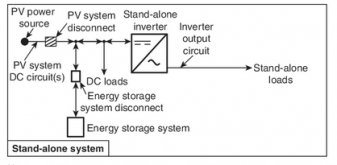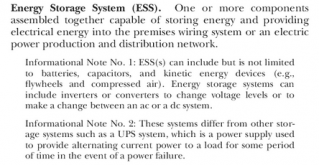hankcurt
Solar Enthusiast
I signed up for the free access to the NFPA codes at https://www.nfpa.org/Codes-and-Standards/All-Codes-and-Standards/Free-access
I think the result of these changes will largely depend upon your code enforcement AHJ. The language in article 690 defines the parts of a photovoltaic system and it shows the ESS (electrical storage system) as separated from the PV and inverter.
Article 706 says that an ESS may include a charge controller or inverter, but also states it doesn't cover uninterruptible power systems (which obviously contain a charge controller and inverter), and the differentiation appears to be if the batteries are used to normally power the system or are only used to power the system during a power failure.
Then there is article 480 on storage batteris, which requires storage batteries to be listed unless they are lead acid batteries (so a little fear of the unknown here). This article might be useful to people assembling battery packs as it covers terminal connection practices, corrosion, conductive battery cases and voltage drop requirements. So even if it doesn't apply to you, it might steer you towards best practices. So how do you know if you have a PV system with storage batteries or an ESS system? I think article 690 leans towards calling batteries connected to a PV system an ESS, but depending upon the complexity of your system, you might be able to call them storage batteries.
Also, article 706 on electrical storage systems goes still goes into all the detail of how an ESS has to be constructed (disconnects, over current protection, wire ampacity, etc.), so might your AHJ say the ESS system listing applies to manufactured systems, but the method of construction and parts requirements apply to DIY constructed systems. I suppose it will depend on their attitude and level of interest.
I think the result of these changes will largely depend upon your code enforcement AHJ. The language in article 690 defines the parts of a photovoltaic system and it shows the ESS (electrical storage system) as separated from the PV and inverter.
Article 706 says that an ESS may include a charge controller or inverter, but also states it doesn't cover uninterruptible power systems (which obviously contain a charge controller and inverter), and the differentiation appears to be if the batteries are used to normally power the system or are only used to power the system during a power failure.
Then there is article 480 on storage batteris, which requires storage batteries to be listed unless they are lead acid batteries (so a little fear of the unknown here). This article might be useful to people assembling battery packs as it covers terminal connection practices, corrosion, conductive battery cases and voltage drop requirements. So even if it doesn't apply to you, it might steer you towards best practices. So how do you know if you have a PV system with storage batteries or an ESS system? I think article 690 leans towards calling batteries connected to a PV system an ESS, but depending upon the complexity of your system, you might be able to call them storage batteries.
Also, article 706 on electrical storage systems goes still goes into all the detail of how an ESS has to be constructed (disconnects, over current protection, wire ampacity, etc.), so might your AHJ say the ESS system listing applies to manufactured systems, but the method of construction and parts requirements apply to DIY constructed systems. I suppose it will depend on their attitude and level of interest.




